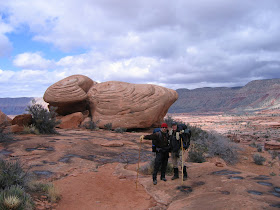

Steve just returned from a Spring Break hike in Grand Canyon National Park with our son Eric and Chris, Eric's friend from Denmark. March is early for hiking from the North Rim, but with snow pack 60% of normal, they were able to reach Monument Point, a great place to begin a trek into the canyon.

The trail looks almost like a sidewalk where slickrock is exposed, but in many places, the trail markings are slim to none.
Here, a cairn (on the left) marks the way.

Potholes on the esplanade (a flat section below the first cliffy descent) held enough water for pumping a fresh supply for a lunch break. Here, Eric and Steve pose with mushroom-shaped rocks.
Manzanita and this cactus were in bloom.
And this barrel cactus is impressive.
At Deer Creek Spring, water flows out of a limestone cave and falls at least a hundred feet to the ground. During maximum spring runoff, the volume would be greater.


The two young guys raced down to the Colorado River, while Steve rested up at camp. Stars that night were incredible.
The next day, they hiked back to the esplanade, where Eric and Chris took a side trip to Thunder Spring. I don't have Eric's photos from this trip yet, so here are some photos I scanned from May, 1999. Thunder Spring also emerges from the cliffs. What appear to be green bushes in the background are actually 100 foot tall cottonwood trees, to provide some perspective.

Here you can better appreciate the powerful cascades during spring runoff.

Steve and our sons (with my daughter and I tagging along on a few occasions) have hiked into the Grand Canyon by many routes, many times over the last 15 years. We have developed a special love and appreciation for this wild, stark country's unique beauty.
For view into other fascinating worlds, click
here.
 K is for krazy kids.
K is for krazy kids.




















































